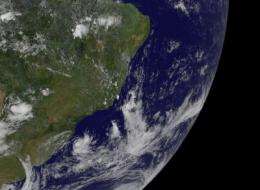90Q: A curious short-lived 'tropical' cyclone in the southern Atlantic

Tropical cyclones typically don't form in the Southern Atlantic because the waters are usually too cool. However, forecasters at the Naval Research Laboratory noted that a low pressure system off the coast of Brazil appeared to have tropical storm-force winds yesterday.
On Wednesday, March 10 at 1400 UTC (9:00 a.m. ET) "System 90Q" was located near 29.8 degrees South latitude and 48.2 degrees West longitude, about 180 miles east of Puerto Alegre, Brazil. The Naval Research Laboratory said on March 10 the system had maximum sustained winds near 39 mph (35 knots) but has weakened today below the tropical storm-force winds threshold.
The Geostationary Operational Environmental Satellite, GOES-12 captured a visible image of System 90Q at 14:45 UTC (9:45 a.m. ET) on March 11, and it appeared as a small circular area of clouds off the Brazilian coast. GOES is operated by the National Oceanic and Atmospheric Administration, and NASA's GOES Project, located at NASA's Goddard Space Flight Center, Greenbelt, Md. creates some of the GOES satellite images.
System 90Q continues to move away from the Brazilian coast and is expected to be absorbed in a mid-latitude cold front in the next couple of days.
Provided by NASA's Goddard Space Flight Center



















